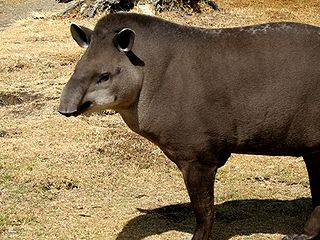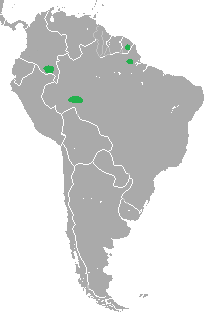 W
WA tapir is a large, herbivorous mammal, similar in shape to a pig, with a short, prehensile nose trunk. Tapirs inhabit jungle and forest regions of South and Central America, and Southeast Asia.
 W
WApril was a tapir living at the Belize Zoo in Belize from 1983 until her death in 2013. She was a Baird's Tapir, the national animal of Belize.
 W
WBaird's tapir, also known as the Central American tapir, is a species of tapir native to Mexico, Central America and northwestern South America. It is one of three Latin American species of tapir.
 W
WThe giant tapir is an extinct species of tapir that lived in southern China, with reports suggesting it also lived in Java and Vietnam. Evidence suggests that the species first appeared in the Early Pleistocene and possibly survived until the early Holocene. It was larger on average than modern tapirs, estimations range from 2.1 metres (6.9 ft) long and 0.9 metres (3.0 ft) tall at the shoulders to 3.5 metres (11 ft) long, and 1.5 metres (4.9 ft) metres tall at the shoulders. It may have weighed up to 500 kilograms (1,100 lb). The species was also placed in its own genus of Megatapirus, however, it is now conventionally placed within Tapirus.
 W
WThe Malayan tapir, also called the Asian tapir, Asiatic tapir, Oriental tapir, Indian tapir, or piebald tapir, is the largest of the four widely-recognized species of tapir and the only one native to Asia. The scientific name refers to the East Indies, the species' natural habitat. In the Malay language, the tapir is commonly referred to as cipan, tenuk or badak tampung.
 W
WMo (貘) was the standard Chinese name for the giant panda from the 3rd century BCE to the 19th century CE, but in 1824, the French sinologist Jean-Pierre Abel-Rémusat mistakenly identified the mo as the recently discovered black-and-white Malayan tapir, which never inhabited China in historical times. He based this misidentification on Chinese woodblock illustrations that depicted a mythological mo (貘) chimera with elephant trunk, rhinoceros eyes, cow tail, and tiger paws, which the famous Tang poet Bai/Bo Juyi first described in the 9th century. The consequences of Abel-Rémusat's error were extensive. His presumption that mo meant "Chinese tapir" was immediately adopted in Western zoology, and by the end of the 19th century it was accepted as modern scientific fact in China and Japan. In the 20th century, since mo had lost its original meaning, the giant panda was given a new Chinese name da xiongmao.
 W
WThe mountain tapir, also known as the Andean tapir or woolly tapir is the smallest of the four widely recognized species of tapir. It is the only one to live outside of tropical rainforests in the wild. It is most easily distinguished from other tapirs by its thick woolly coat and white lips.
 W
WThe South American tapir, also commonly called the Brazilian tapir, the Amazonian tapir, the maned tapir, the lowland tapir, in Portuguese anta, and in mixed Quechua and Spanish sachavaca, is one of the four widely recognized species in the tapir family, along with the mountain tapir, the Malayan tapir, and Baird's tapir. The South American tapir is the largest surviving native terrestrial mammal in the Amazon.
 W
WTapiroidea is a superfamily of perissodactyls which includes the modern tapir. Members of the superfamily are small to large browsing mammals, roughly pig-like in shape, with short, prehensile snouts. Their closest relatives are the other odd-toed ungulates, including horses and rhinoceroses. Taxonomically, they are placed in suborder Ceratomorpha along with the rhino superfamily, Rhinocerotoidea. The first members of Tapiroidea appeared during the Early Eocene, 55 million years ago.
 W
WTapirus kabomani is a partially-recognized species of tapir, large browsing mammals similar in shape to a pig. It is the smallest tapir species, even smaller than the mountain tapir, which had been considered the smallest. T. kabomani is found in the Amazon rainforest, where it appears to be sympatric with the South American tapir. When it was announced in December 2013, T. kabomani was the first odd-toed ungulate discovered in over 100 years. T. kabomani has not been recognized by the Tapir Specialist Group as a distinct species and recent genetic evidence further suggests it is actually nested within T. terrestris.